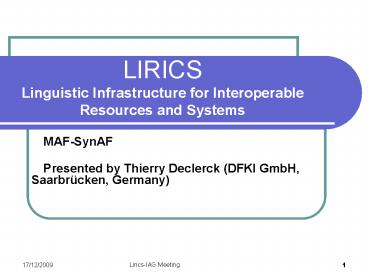LIRICS Linguistic Infrastructure for Interoperable Resources and Systems - PowerPoint PPT Presentation
1 / 9
Title:
LIRICS Linguistic Infrastructure for Interoperable Resources and Systems
Description:
Linguistic Infrastructure for Interoperable Resources and Systems. MAF-SynAF ... morpho-syntactic contents for all human language, MAF is more modestly dedicated ... – PowerPoint PPT presentation
Number of Views:42
Avg rating:3.0/5.0
Title: LIRICS Linguistic Infrastructure for Interoperable Resources and Systems
1
LIRICS Linguistic Infrastructure for
Interoperable Resources and Systems
- ?MAF-SynAF
- ?Presented by Thierry Declerck (DFKI GmbH,
Saarbrücken, Germany)
2
MAF
- Morpho-Syntactic Annotations provide an important
- layer of linguistic information to a document.
Large - amount of corpora have been and are still
manually annotated, - while more and more annotations are now
automatically - produced by linguistic tools. Many NLP tasks
(such - as terminology extraction, information
extraction, parsing, - . . . ) rely on these morpho-syntactic
annotations
3
MAF Goals
- Towards the very ambitious goal of providing for
a (unique) tagset organizing morpho-syntactic
contents for all human language, MAF is more
modestly dedicated to explore and propose a
generic way to anchor, structure and organize
annotations completed by mechanisms to specify
comparable tagsets and annotation contents.
4
MAF Format
- As many recent standardization proposals, we
favor - the use of XML representations, because they
ensure both human readability and easier machine
processing. Still, these XML representations
should rely on some consistent XML-independent
model. In our case, the ISO proposal on feature
structures for language data.
5
MAF Format
- As many recent standardization proposals, we
favor - the use of XML representations, because they
ensure both human readability and easier machine
processing. Still, these XML representations
should rely on some consistent XML-independent
model. In our case, the ISO proposal on feature
structures for language data.
6
MAF Terminology
- The terminology or set of categories (types,
features, and feature values) used in tagsets are
described w.r.t. registered data categories whose
meaning has been clearly stated. Feature
structures and registered data categories provide
a promising direction to build tagsets that may
be automatically compared, even if only
approximatively.
7
MAF Terminology
- Basic Units (words, tokens), problem of
segmentation - Ambiguities morphological, lexical ?how to
represent them?
8
MAF Metadata
- Metadata are needed, for instance, for specifying
the - author (or tool) of a set of annotations, the
date, the confidence, - .However, we do not plan to provide a specific
- mechanism to handle metadata but rather to rely
on other proposals (IMDI probably a good
candidate).
9
SynAF A new work item
- See the document
- Dependency Structures seen as very important
(both for Semantic Web applications as well as
for Multimedia applications) - Call for contribution































